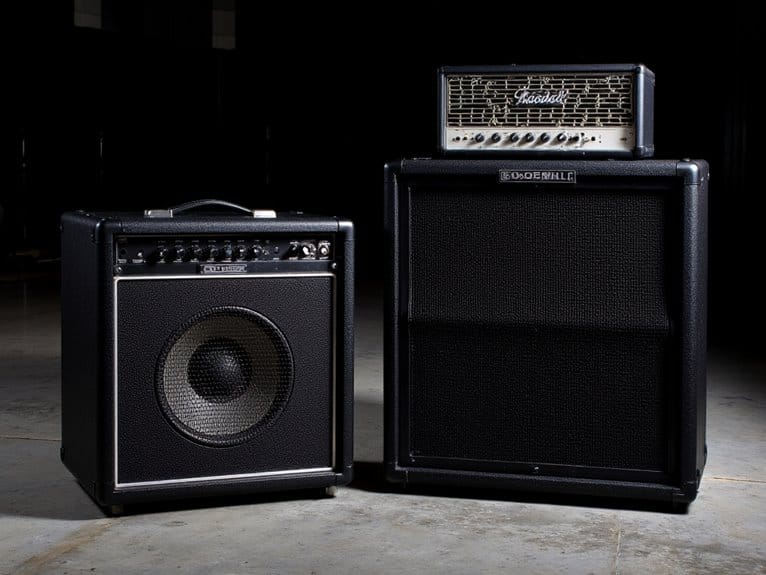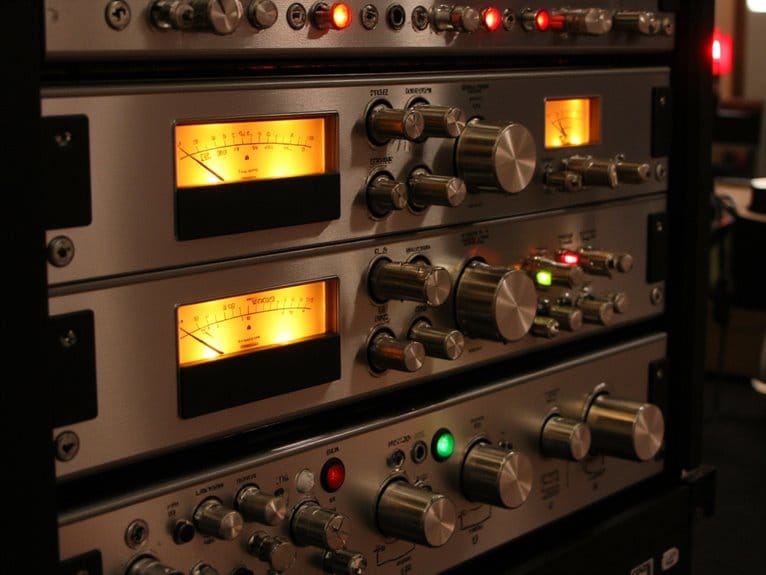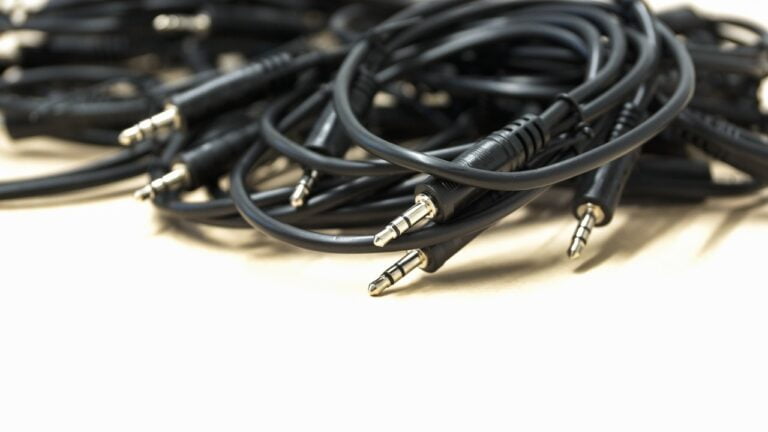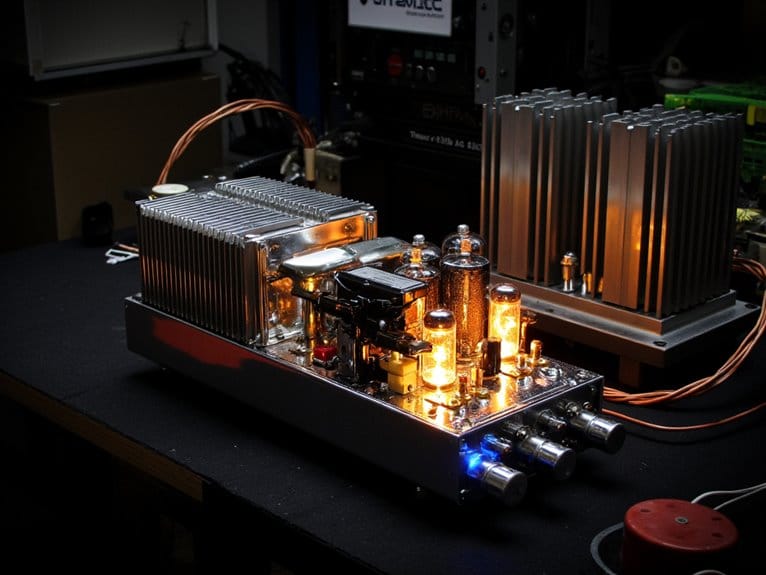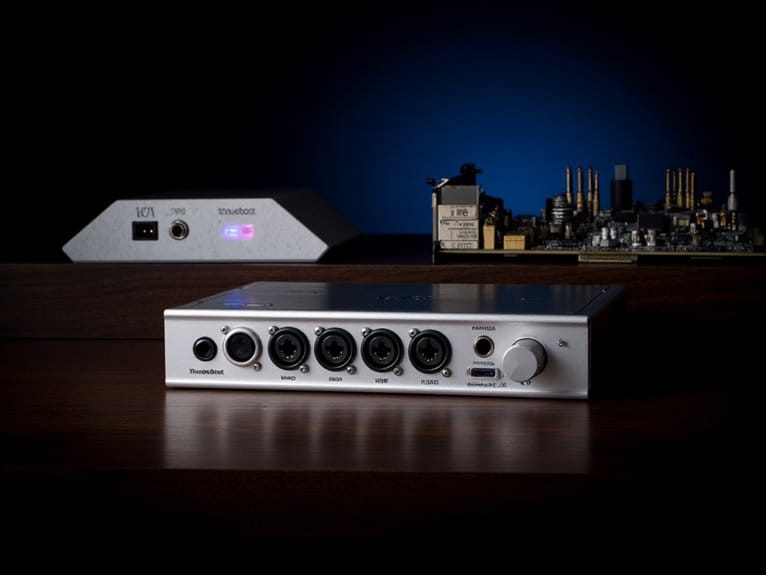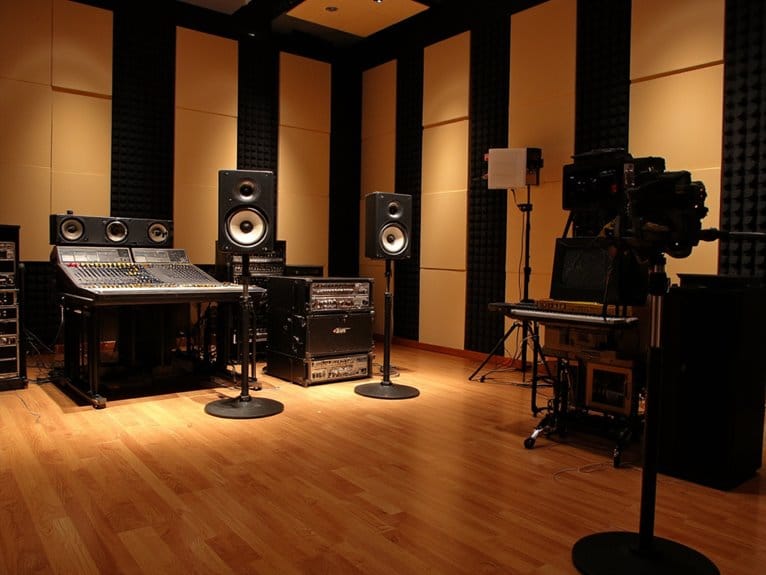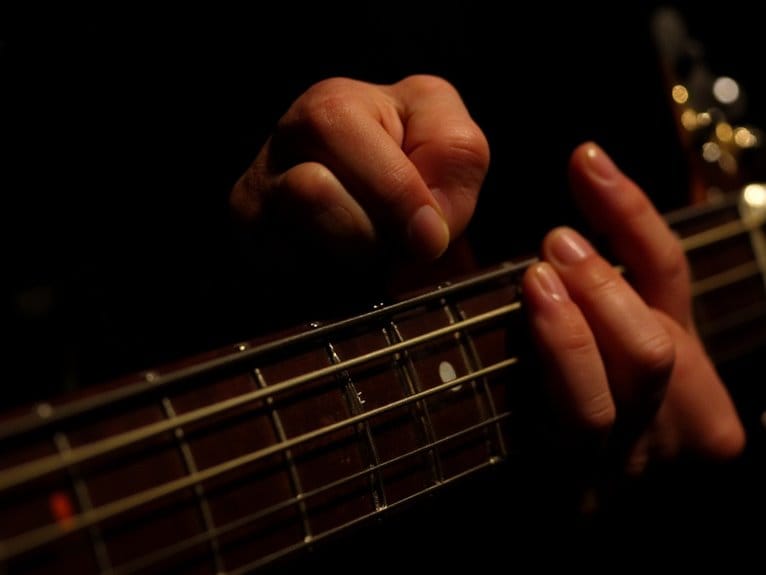Bass Combo Vs Head and Cabinet Configurations
Bass combo amps offer integrated simplicity with factory-matched voicing, making them ideal for beginners who need straightforward setup and consistent sound, though they typically max out around 200-500 watts and limit upgrade flexibility. Head-and-cabinet systems require larger upfront investment but provide modular customization through speaker swaps, deliver 500-2000+ watts for larger venues, distribute weight better for transport, and retain superior resale value since you can sell components individually—exploring these configurations further reveals essential considerations for your specific playing needs.
We are supported by our audience. When you purchase through links on our site, we may earn an affiliate commission, at no extra cost for you. Learn more.
Notable Insights
- Combo amps offer integrated design with simpler setup, while head and cabinet systems provide modular flexibility for speaker swaps and tonal customization.
- Head and cabinet setups deliver higher power output (500-2000+ watts) compared to combo amps which typically max out around 200-500 watts.
- Separate components distribute weight better for easier transport, while combos concentrate weight causing potential balance and mobility issues.
- Head and cabinet systems retain better resale value through individual component sales, whereas combo upgrades require replacing the entire unit.
- Combos suit beginners and smaller venues with lower upfront costs, while modular rigs benefit experienced players needing power and versatility.
Understanding the Fundamental Differences Between Bass Amp Configurations
When I first started playing bass seriously, I’ll admit I was completely overwhelmed by the choice between combo amps and head-and-cabinet setups.
However, understanding their fundamental differences comes down to four key areas that’ll directly impact your playing experience.
Combo advantages include integrated design, simpler setup, and fewer connection points that could fail, while head disadvantages involve managing separate components and proper impedance matching between units.
However, cabinet flexibility with modular systems allows you to swap speakers for different venues, and modular upgrades let you improve individual components without replacing everything. The metal chassis construction in quality head units provides superior durability for the rigors of frequent transport between gigs.
Sound consistency remains more predictable with combos, though heads offer greater tonal versatility through different cabinet pairings. Head and cab rigs typically deliver more volume capacity due to their ability to accommodate larger cabinets and higher power outputs.
Professional bassists often enhance their signal chain with bass preamp pedals that provide additional tonal shaping and DI capabilities regardless of their amplifier configuration. For beginners who want to avoid the complexities of matching components, a combo amp may be ideal for those less familiar with equipment nuances.
Versatility and Modularity: Customization Options for Your Sound
While I’ve always appreciated the straightforward nature of combo amps, I’ll be the first to admit that head-and-cabinet systems completely changed my perspective on what’s possible when you need serious customization options for your sound.
Head-and-cabinet systems opened my eyes to customization possibilities that combo amps simply can’t match for serious players.
The modular systems benefits become immediately apparent when you’re swapping out cabinets to match different venues, or pairing vintage speakers with modern amp heads for custom tone experimentation that simply isn’t achievable with fixed combos.
You’ll find that aging speakers naturally produces smoother, more musical tones, while fresh drivers deliver sharper attack and brightness.
This flexibility extends beyond hardware too—software like Logic Pro’s Bass Amp Designer lets you virtually mix and match components, creating unique sonic combinations that would be impossible, or at least expensive, to achieve physically.
When considering modular setups, proper speaker pairing becomes crucial for optimal power distribution and tonal performance, especially when matching impedance ratings between your amp head and cabinet configuration.
Portability and Weight Distribution Considerations
Beyond the sonic flexibility that modular systems provide, there’s another practical reality that’ll quickly become apparent once you start gigging regularly: the physical demands of moving your gear from venue to venue can make or break your enthusiasm for live performance.
Weight management becomes essential when you’re hauling equipment up three flights of stairs to that trendy rooftop venue. Here’s what I’ve learned about carrying techniques:
- Combos concentrate weight in one awkward package, often creating top-heavy balance issues that strain your back.
- Head/cab setups distribute load across two manageable pieces, reducing individual lifting stress.
- Modular configurations offer flexibility in transport methods, allowing you to prioritize lighter components first.
The centralized weight distribution in combos can feel cumbersome, while separating components provides tactical advantages for maneuvering tight spaces and vehicle loading.
Tone Shaping and Sound Quality Capabilities
Although the physical differences between combos and head/cabinet setups grab most of the attention, the real magic happens in how these configurations shape your sound, and I’ll admit I was surprised to discover just how much the amp’s architecture affects your tonal possibilities.
Your preamp impact remains consistent whether you’re using a combo or separate head, since both feature identical signal processing capabilities, EQ options, and frequency response characteristics.
However, speaker characteristics and cabinet design create the most significant tonal differences between these configurations.
Combos offer factory-matched voicing that guarantees cohesive sound clarity, while separate rigs provide superior tonal flexibility for experimenting with different cabinet designs, whether you prefer tight sealed enclosures or extended low-end from ported designs, accommodating your specific distortion preference and sonic requirements. Quality signal transmission between your bass and amplifier becomes crucial regardless of your chosen configuration, as proper cable connections ensure your carefully crafted tone reaches your speakers without interference or signal degradation.
Many bassists enhance their core amplifier setup with effects processors that feature cabinet IR modeling to further customize their sound, allowing precise tonal sculpting that complements their chosen amp configuration.
Power Output and Wattage Requirements for Different Venues
When you’re choosing between combo amps and head-cabinet setups, understanding how wattage requirements scale with venue size becomes essential for making the right investment decision.
Your power needs can range dramatically from 15 watts for bedroom practice to 500+ watts for outdoor gigs, and the configuration you select—whether it’s an all-in-one combo or a modular head and cab system—directly impacts your ability to meet these varying demands efficiently.
I’ve found that while combos offer convenient, fixed wattage solutions perfect for consistent venue types, head and cabinet rigs provide the flexibility to scale your power output by adding or swapping components as your performance requirements evolve.
For home practice sessions specifically, 10-15 watts provides adequate volume for individual rehearsals, while 30+ watts becomes necessary when you need to accommodate small gigs or studio monitoring situations.
The balanced output design found in professional amplification systems helps eliminate interference issues that can plague lower-quality setups, particularly important when running long cable connections between your head and cabinet components.
Venue Size Wattage Matching
Getting the wattage right for your venue size isn’t just about having enough power—it’s about finding that sweet spot where your bass cuts through the mix without overpowering the room or straining your amp.
Here’s how I match venue power requirements for peak amp efficiency:
- Small venues (up to 100 people): You’ll need 100-200 watts to compete with drums and maintain clean headroom during slap passages or dynamic accents.
- Medium venues (100-300 people): 200-500 watts becomes essential when you’re fighting louder stage volumes and potentially inadequate PA systems.
- Large venues/festivals: 500+ watts with multiple cabinets ensures your low-end reaches every corner without compromising tone clarity. Budget instruments can benefit from professional setups to maximize their performance potential at these demanding venues.
Bass frequencies demand considerably more wattage than guitar to reproduce cleanly at volume, and underpowering your setup risks speaker damage when you push harder to compensate. Remember that your bass guitar’s pickup configuration plays a crucial role in how efficiently your amp translates that power into the room, with active pickups typically requiring less gain staging than passive systems.
Combo Vs Head Power
Once you’ve determined your venue’s power needs, the next decision becomes whether a combo amp or head-and-cabinet setup will deliver that wattage most effectively for your specific situation.
Here’s where power efficiency becomes vital, and frankly, where many wattage myths start clouding judgment. Combos typically max out around 200-500 watts, which works fine for most gigs, but they’re often less efficient due to smaller built-in speakers that can’t fully utilize available power.
Head-and-cabinet rigs, however, can push 500-2000+ watts while maintaining better headroom and cleaner output. You’ll find that a 300-watt head paired with a quality cabinet often outperforms a similarly rated combo because it’s designed specifically for power efficiency, not portability compromises. Much like audio interfaces require proper phantom power for condenser microphones to function optimally, bass amplifiers need adequate wattage reserves to handle dynamic peaks without distortion.
For those prioritizing mobility, consider that lightweight designs in the 2-5 pound range offer excellent portability, though these battery-powered options typically sacrifice the raw wattage capabilities of traditional plug-in configurations.
Cost Analysis and Long-Term Investment Value
When you’re weighing the financial impact of your bass rig decision, you’ll find that combo amps typically offer lower upfront costs but may limit your flexibility for future upgrades.
On the other hand, head and cabinet systems require a larger initial investment that often pays dividends through modular expansion possibilities.
Your upgrade path economics become significant here, since combos fundamentally lock you into replacing the entire unit when you outgrow its capabilities, whereas separate components let you swap out individual pieces as your needs evolve.
I’ve learned that resale value considerations favor the head and cab approach too, as individual components often retain their worth better than integrated combo units, especially when you can sell a quality cabinet that outlasts multiple amp heads over the years.
Similar to how budget tube amplifiers under $500 balance power output requirements with cost-effectiveness, your bass rig choice should align with both your current needs and future expansion plans.
Upgrade Path Economics
While the initial sticker price might favor combos, the real financial story unfolds over years of ownership, where seemingly innocent upgrade decisions can either drain your bank account or build a flexible rig that grows with your needs.
Head and cabinet systems excel in upgrade strategies, allowing you to replace individual components incrementally rather than scrapping entire units. When your playing demands more power, you’ll simply swap the head or add cabinets, spreading costs over time instead of facing massive single purchases.
This investment flexibility becomes vital as your musical journey evolves, because combo amps trap you into all-or-nothing upgrades that often mean starting from scratch, ultimately costing more than modular approaches that adapt to changing requirements. Similar to guitar pickup upgrades where output levels must match your playing style and amplifier compatibility, bass rig components need strategic pairing for optimal performance and value retention. For budget-conscious musicians, quality small bass amps in the $50-150 range can serve as excellent practice companions while you build toward a full head and cabinet system.
Choosing the Right Setup for Your Playing Style and Needs
When you’re deciding between a bass combo and a head-and-cabinet setup, your playing environment and musical goals should drive the decision more than any single technical specification or feature list.
Home players and studio musicians typically find combos ideal for their compact size, integrated design, and faster setup times.
For home practice and studio work, combo amps deliver the perfect blend of convenience and integrated functionality.
If you’re gigging regularly, head-and-cabinet rigs offer the modularity and stage volume you’ll need for larger venues.
Your bass genre preferences matter too—jazz and acoustic settings often work well with combos, while rock, metal, and electronic genres benefit from the power and customization potential of modular systems. For rock specifically, ensuring your amplifier has extensive tone controls for frequency shaping will help you achieve the punchy sound that defines the genre.
Consider your physical limitations, transportation needs, and whether you prioritize convenience over ultimate tonal flexibility when making your final choice.
For beginners entering this decision-making process, entry-level amps between $100 and $300 provide solid sound quality without excessive costs, regardless of whether you choose combo or modular configurations.
Frequently Asked Questions
Can I Use Guitar Speakers With a Bass Head Without Damaging Them?
You shouldn’t use guitar speakers with bass heads due to poor amplifier compatibility. Guitar speakers can’t handle low frequencies properly, causing distortion, cone damage, or complete failure from excessive excursion and power stress.
Do Tube Bass Heads Require More Maintenance Than Solid-State Models?
Yes, you’ll find tube maintenance demands much more attention than solid state durability. You’ll need regular bias adjustments, tube replacements, and warm-up time, while solid-state models require minimal upkeep and last longer.
On a final note
You’ll need to weigh your priorities when choosing between these configurations. If you’re gigging regularly at different venues, a head and cabinet setup offers the modularity you’ll appreciate for tone sculpting and power scaling. However, if you’re practicing at home, recording in studios, or playing smaller gigs where convenience matters most, a quality combo amp will serve you well without breaking your back or budget.

